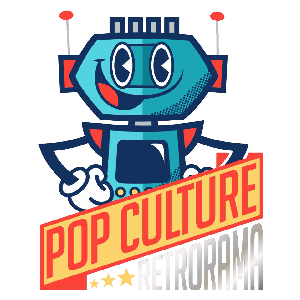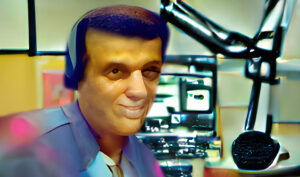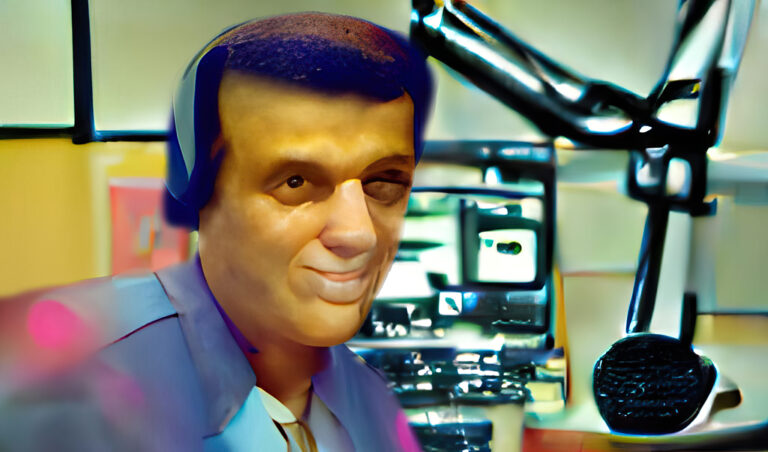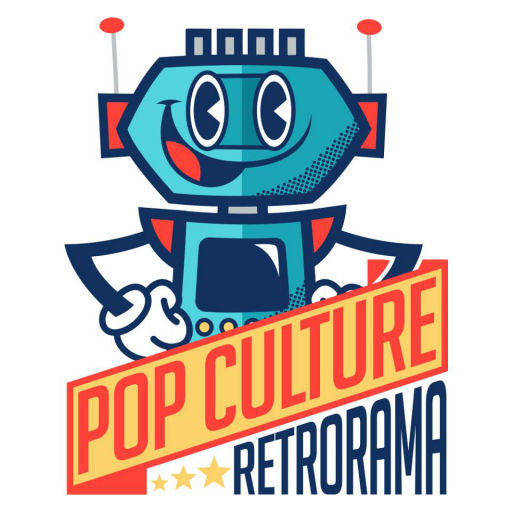Mid-1980s American TV sci-fi had a name – or, really, just a letter – but it didn’t even start out as sci-fi.
Until Star Trek: The Next Generation came along, the quintessential 1980s American sci-fi TV series was arguably Kenneth Johnson’s V, which begin life as an allegorical look at attempts to resist Nazi occupation in World War II. Johnson, who had previously worked on The Incredible Hulk’s television incarnation, wanted to bring the message of those historical events into modern times and give the Nazis a new face. Originally, V started out as a non-science-fiction movie screenplay called Storm Warnings, in which another country (not another planet) insidiously takes over America with Third Reich-like tactics, but with science fiction particularly hot at that time, Johnson turned his modern-day Nazis into reptilian humanoids who could assume human disguise, but craved Earth’s animals (including humankind) as a vast new supply of food, and the planet’s abundant water.
Pitched to NBC as a big-budget miniseries, the original V was one of the priciest TV productions to be mounted since the original Battlestar Galactica. Impressive models were made, as well as full-scale mockups of such vehicles as the alien Visitors’ shuttles and fighters, and in some cases the sets were vast. The latest advances in optical special effects were utilized, giving the original V an impressively big-screen quality. As for the story, Kenneth Johnson wasn’t exactly shooting for subtlety: the Visitors’ insignia closely echoed the swastika, and to drive home the World War II allegory, Johnson even wrote a Jewish Holocaust survivor (with an all-too-eager collaborator for a grandson) into his story.

The style of the times dictated certain elements of V, and nowhere was this so plainly evident as with one of the miniseries’ stars, Diana, played in a sometimes over-the-top (and arguably prime-time-soap-inspired) style by Jane Badler. In fairness, however, the show’s male lead, played by square-jawed Marc Singer (later to star in the Beastmaster films, and cast only three days before principal photography began on V), wasn’t far behind her.
V struck a chord with the audience, and NBC was rewarded with a generous share in the ratings. Between V’s relatively high ratings and its slightly ambiguous “end of a battle but the beginning of the war” conclusion, everything seemed to be in place for a sequel, and indeed NBC quickly placed an order with Warner Bros. for a follow-up. Kenneth Johnson began working on his ideas for further skirmishes between the people of Earth and the alien Visitors. But he wouldn’t be able see that vision through.

As pleased as NBC was with V’s ratings, they asked for significant changes to the format. Instead of the grim WWII European allegory Johnson built into the first miniseries, NBC wanted the upcoming V: The Final Battle to be action-adventure fare. This conflicted with Johnson’s somber vision for the climactic battle, and he took his leave of the project. Writer Brian Taggert, with a variety of collaborators (including Diane Frolov, who would later work with Johnson on Alien Nation), took over the scripting duties and crafted it into the epic adventure that NBC wanted, but the changes weren’t over yet. NBC exerted its influence over the sound of the show as well, rejecting the musical score by Barry DeVorzon and Joseph Conlan just a week before broadcast. It was too late to rescore the first two-hour installment, but Dennis McCarthy, a former rock musician who had broken into TV as arranger for the Glen Campbell Good Time Hour and later launched his scoring career with the Dukes Of Hazzard spin-off Enos, took over on short notice, with only a week to write, arrange and record the remainder of the miniseries’ fully orchestral score.
Introduced in The Final Battle was the hard-edged mercenary character Ham Tyler, played by future genre series and movie fixture Michael Ironside, and he quickly became a fan favorite. Another actor who had a featured role in both miniseries was Robert Englund, as the inoffensive Willie, who grew to sympathize with the human Resistance. He was cast soon afterward as Freddy Kreuger in Wes Craven’s A Nightmare On Elm Street.

Premiering later in 1984, a weekly series saw the return of Kenneth Johnson as executive producer. Johnson’s plan, instead of what became V: The Final Battle, would have been to produce at least two 2-hour V movies per year to continue the story, and in a somewhat surprising move given the split between Warner Bros./NBC and Johnson, he was brought back to oversee the series, using his still-unfilmed movie-of-the-week ideas as the backbone of the continuing plotline.
The weekly series continued to ramp up the soap opera-inspired elements, especially with a catty rivalry between Jane Badler’s Diana and a rival Visitor named Lydia. Occasionally throwing a dash of cold water on this heated power struggle was Richard Herd as a Visitor commander named Charles (Herd later guest starred in several episodes of Star Trek: Voyager as Tom Paris’ father).

On the Resistance side, much of the original V/Final Battle cast stayed on, though the rigors of weekly shooting were deemed too demanding for a child actor, so an explanation was devised to age Elizabeth into her late teens/early 20s in the form of actress Jennifer Cooke. Some of the other cast members either left the show or were dropped from the series format, enabling the show to maintain something of a gritty edge by killing them off, showing that life wasn’t safe for the Resistance just yet.
The Achilles’ heel of the series, however, proved to be the spectacularly expensive sets and special effects. The costs of tying up studio space for such sets as the Visitors’ mothership hangar was considerable, and the continued use of film-based opticals for spaceship shots and laser guns ran the show’s budget into the ground. At one point, effects shots from George Pal’s War Of The Worlds were spliced into an episode of the series, because there simply wasn’t enough left in the budget to create new effects.

Kenneth Johnson’s plan was to end the first season with the victory of the Resistance over the Visitors, with at least an entire mothership of Visitors forced down on Earth and its occupants taken prisoner. Johnson then would have turned the Holocaust metaphor on its ear, with the Visitors assimilated into Earth society as an underclass now facing discrimination. Donovan and some of the former Resistance members would have then turned their energies to fighting for the Visitors’ survival – at least, those Visitors who could be trusted. Naturally, some of the Visitors would be trying to contact home and summon reinforcements, and that very easily could have led into a third season. In the meantime, grounding the second-season action in modern-day Earth locations and studio sets, with few (if any) forays into space, was Johnson’s well-planned answer to the first season’s out-of-control spending. But V: The Series was cancelled before Johnson’s master scheme could play out; a few years later, he would later incorporate elements of his long-term second season plan into the first and only season of his well-received TV adaptation of the movie Alien Nation.

In the interim, as with many SF series of the 70s and 80s, absence made many a fan’s heart grow fonder. In the wake of the series’ cancellation, original novels were published by Pocket Books, and there were even a few toys, including a large, non-character-specific Visitor figure whose human face could be removed to reveal the lizard underneath. Kenneth Johnson’s Alien Nation series lasted but a single season, but a few years later Fox TV relented and Johnson returned to produce and direct several TV movies picking up where the series left off and continuing the story from there. After that, Johnson turned his attention to V again. And it wasn’t an unreasonable idea: in the intervening years, Star Trek had returned from its cancellation death and become a bigger hit than ever before. Dark Shadows had enjoyed a brief resurgence on ABC, and of course, Fox had finally heeded the cries of fandom and brought Alien Nation back. On the big screen, everything from Lost In Space to Godzilla had been revived (and, it must be said, revised) with varying degrees of success.
And his reasoning didn’t fall on deaf ears: NBC was willing to commission a new version of V as a project in development. (It wasn’t the first time the network considered it; in the late 80s a pilot script for a sequel series was commissioned from writer J. Michael Straczynski, but despite several revisions and additional drafts, it was scrapped for its anticipated astronomical cost. Straczynski apparently impressed the Warner Bros. brass, however; the studio later produced his own sci-fi creation, Babylon 5.)

Johnson’s proposal was to rejoin the original characters, and their younger descendants and colleagues, some 20 years after the original miniseries as a second Visitor invasion took place. This announcement was followed by a long silence, after which word finally leaked out that NBC simply hadn’t been impressed with the script and concept presented. NBC even shopped the revival idea to its new corporate sibling, Sci-Fi Channel, which also passed on the series (NBC had, at the time, just bought Universal Studios, who owned Sci-Fi), citing that the revival series simply didn’t differentiate itself enough from the original. But somewhat paradoxically, NBC later asked Johnson to consider a complete retelling of the story, essentially beginning with a remake of the original miniseries. The reboot camp eventually won out, with a completely re-imagined version of V premiering in late 2009 on ABC. Kenneth Johnson’s name wasn’t completely removed from the new version, however: despite massive changes made to the show’s premise and cast of characters, Writers’ Guild of American arbitration preserved Johnson’s credit as creator of the series, and as such his name appeared in the opening credits of every episode.





Kenneth Johnson had absolutely nothing to do with V after he quit the final battle,so he definitely wasn’t involved in the series,which he has never even seen.
Richard Herd played John,not Charles (he was played by Duncan Regher)